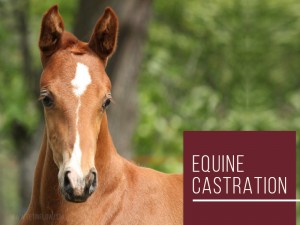
Equine castration

Equine castration is a very common procedure in which the veterinary surgeon removes both testicles from a horse under the effect of anaesthesia. This procedure is usually carried out for management issues and to prevent unwanted pregnancy.
Stallions often become very difficult to handle as they get older. They may try to establish herd dominance by fighting with other male horses and they will also try to mate with the females, leading to unexpected and unwanted pregnancies. This procedure removes the testicles, which are the primary source of hormones, decreasing the horse's display of male sexual behaviour. After neutering horses become more docile and a lot more manageable. The procedure will also prevent other problems such as testicular tumours and inguinal hernias.
Colts can be castrated at any age but if owners want to avoid the appearance of sexual behaviour, horses should be castrated by the time they are two years old. Vets often prefer to castrate earlier as it this usually means less risks and complications.
The procedure can be done at your home or at a veterinary surgery. It is usually carried out during autumn to avoid the flies or during spring to avoid the wet winter weather.
Your veterinary surgeon will always do a complete physical examination on your horse to make sure he is fit for surgery. In addition, it is very important for the horse to be protected against tetanus. If the primary course of vaccinations is not complete, tetanus antitoxin will be administered at the time of castration to provide immediate protection against the disease.
There are different techniques to perform this procedure. The surgery might take place with the horse standing and under heavy sedation or more commonly with the horse lying down. In general this is a safe surgery and castrated horses experience very few postoperative complications, but as with any operation there are risks. Although the incidence of anaesthetic deaths is low it can occur in healthy horses and for no apparent reason. Other risks include post-operative bleeding, injury as a result of a poor recovery once the anaesthetic wears off, scrotal herniation and infection.
Some swelling around the area after the surgery is normal and it usually takes 3-5 days to disappear. The wound can take up to 3 weeks to heal and the horse is usually able to return to work after a month.
Most wounds heal without any complications but it is recommended to monitor the horse closely after surgery. If you notice that the swelling seems to be getting worse or lasting longer than expected, if you notice any material protruding from the incision site, excessive bleeding or if the horse seems depressed and with lack of appetite, contact your veterinary surgeon for advice.
It's very important for horse owners to remember not to turn their colt out with mares for three months after the procedure as they will potentially remain fertile during this period.
Would you like to know more about horses? Check our Equine Courses:
![]()
Equine courses
Read the previous article: Are you ready to get a new dog?

